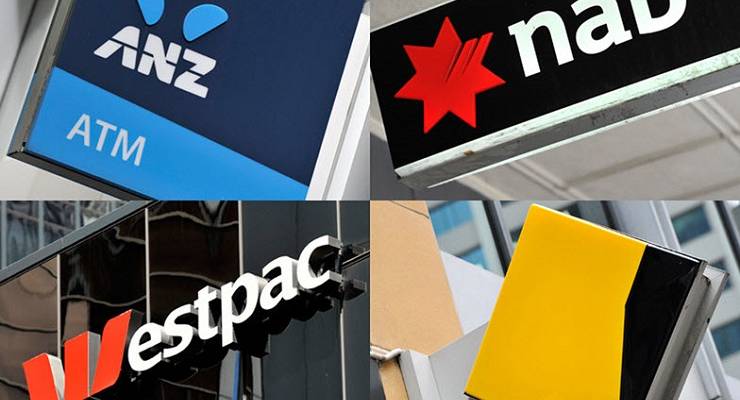
This year’s political donations data from the Australian Electoral Commission (AEC) give us a great example of how, for some of Australia’s biggest corporations, disclosure of contributions to political parties is, to a large extent, voluntary.
Yesterday, Crikey reported on how donations from the big four consulting firms have surged while donations from the big four banks had declined.
But a closer look shows that’s not the full story. It’s true that donations from the Commonwealth Bank, ANZ, Westpac and NAB have, collectively, fallen a lot since five years ago — from $600,000-700,000 a year to, as we’ll explain later, around half that. NAB stopped giving altogether in 2016. And for 2018-19, the Commonwealth Bank and ANZ reported no donations to the AEC.
But CBA and ANZ both gave a lot of money to both parties. Why didn’t they report it?
Under Commonwealth law, you only have to declare donations. If you buy a seat at a party fundraiser where you sit with a minister or shadow minister and bend their ear about policy or regulation, you don’t have to report that if you’re a donor (because you purchased something, rather than just donating), and a party doesn’t have to report it if it’s under the disclosure threshold, currently around $14,000.
If they are reported in a party return, they’re described as “other receipts” and you can usually spot them because they have a GST-style figure — $16,500 is a $15,000 contribution with GST, $27,500 is $25,000 with GST, etc.
In Labor’s case, its branches normally report all of those contributions anyway, if they’re above $1000 (the original reporting threshold before John Howard changed the law to reduce transparency). The Coalition only reports what it is compelled to report.
Now, which is better for democracy: a straight donation? Or attending a fundraiser and using it to lobby a minister to change a regulation, amend a policy or provide a handout?
The latter is effectively a form of soft corruption — corporations with substantial resources purchasing access to policymakers in secret (fundraisers are not open to the public and rarely reported on) to change their minds on policy matters.
ANZ has a policy of not attending fundraisers because “involvement in political fundraising activities can lead to perceptions of cash for access or favours”.
Instead, in its most recent annual report, ANZ states “our policy is that we will make an annual donation to the two major federal parties to support the democratic process in Australia. In the 2019 calendar year, we donated $100,000 to the Liberal Party of Australia and $100,000 to the Australian Labor Party.”
Note calendar year — ANZ made its donations in October last year, it told Crikey, so they won’t show up until the 2019-20 data is released in 2021.
That’s fair enough — in its 2017-18 donations data, ANZ reported giving not one but two donations to each party, one of $150,000 in October 2017 and a second, of $100,000, in June 2018.
It’s a different case with CBA. If you check its annual report, it admits:
Our Group Government Relations Policy explicitly precludes the Bank from making political donations. However, we pay to attend some political events aimed at the business community. To attend these events in the 2019 financial year we contributed $73,000 to the Australian Labor Party, $75,720 to the Liberal Party of Australia and $13,750 to the National Party of Australia. These payments are disclosed in line with the requirements of Federal and State governments
But CBA didn’t disclose these to the AEC, because as fundraising “purchases” they’re not — under Commonwealth law — disclosable. But federal Labor did report them, including one contribution of $55,000.
Receipts reported by a political party from a bank aren’t necessarily contributions — they could be interest, or a loan, but $55,000 is a GST figure, presumably for a subscription to a multi-event fundraiser. Queensland Labor also reported contributions from the Commonwealth.
Westpac also attends party fundraisers, but it discloses all of them to the AEC — every single dollar, even amounts far below Labor’s threshold of $1000. So does Macquarie Bank.
But for the CBA, you have to go deep into their annual report to get the full picture of how the bank has tried to buy access to policymakers in order to influence them.
With the CBA’s amounts added, the total big four donations and contributions in 2018-19 total around $370,000, easily the lowest of recent years, but still substantial funding.
NAB stopped giving money to politicians at all, which is the best policy for a democracy. ANZ has opted to not try to buy access and influence. That’s the next best approach. Westpac (and Mac Bank) buy access, but disclose it well beyond what they are required to do. Only CBA tries to buy influence and skulks in the dark over reporting it, hiding behind the letter of the law. If it’s good enough for investors to be told, it’s surely good enough for voters as well.
Better yet, none of these decisions should be left to the good will of banking executives.








Crikey is committed to hosting lively discussions. Help us keep the conversation useful, interesting and welcoming. We aim to publish comments quickly in the interest of promoting robust conversation, but we’re a small team and we deploy filters to protect against legal risk. Occasionally your comment may be held up while we review, but we’re working as fast as we can to keep the conversation rolling.
The Crikey comment section is members-only content. Please subscribe to leave a comment.
The Crikey comment section is members-only content. Please login to leave a comment.